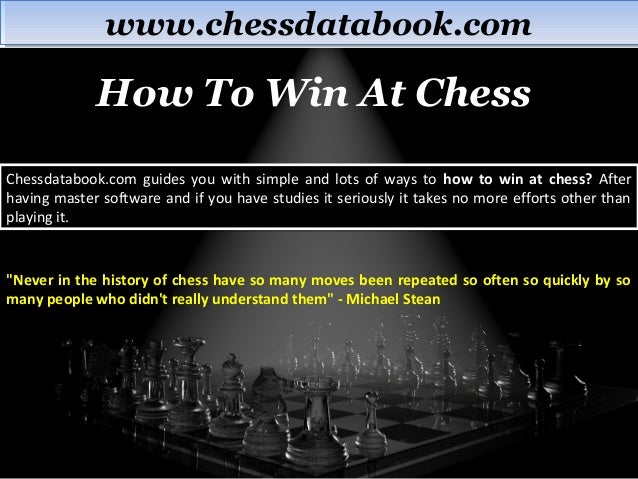A chess opening theory table or ECO table (Encyclopaedia of Chess Openings) presents lines of moves, typically (but not always) from the starting position. Notatedchess moves are presented in the table from left to right. Variations on a given line are given horizontally below the parent line.
The latest opening theory! Chesspublishing.com is an online publisher of chess opening theory. We employ 10 GMs and 4 IMs who publish monthly opening articles, downloadable PGN files, PDF eBooks and playable eBooks. The updates are also available to subscribers on the free Forward Chess app, for iOS and Android. $19.50 for 12 months of access. The English is a chess Opening that happens after the move 1.c4 and can lead to both classical and modern positions. How To Reach The English Opening The English happens after White moves his c-pawn two squares: 1.c4 See what it looks like below. There is a large body of theory regarding how the game should be played in each of these phases, especially the opening and endgame. Those who write about chess theory, who are often also eminent players, are referred to as 'theorists' or 'theoreticians'. In this chess basics video, we talk about the fundamentals of the opening chess principles and how you should use them in your chess game.
Arrangement[edit]
Chess opening theory tables are commonly published in opening books with annotations by experienced chess players. These tables are typically arranged in a compact manner to allow experienced players to see variations from a position quickly. Usually, the table indicates that either White or Black has equal, slightly better, or better chances at the end of the variation. Often, this information is distilled down to mere symbols ('Σ' for example) or the percentage of games (usually tournament games) where White won – no information is usually given on what the assessment is based on or how to proceed in the game.
Shortcomings[edit]
Chess opening theory books that provide these tables are usually quite large and difficult for beginners to use. Because the table entries typically do not include the themes or goals involved in a given line, beginners will either try to memorize the tables or simply drown in the detail. The Wikibook Chess Opening Theory aims to bridge this gap by providing this type of information at the end of each line.
Notation[edit]
Typically, each table has a heading indicating the moves required to reach the position for which the table provides an analysis. The example below is for the opening position, so no moves are shown in the heading. The first row provides the move numbers with subsequent rows representing different variations. Since the initial position is not always the opening position, these numbers will not always start at '1.' White half-moves are shown above black half-moves. Ellipses (...) represent moves that, for the variation, are identical to the variation above. Bold type indicates that another variation is considered elsewhere – usually in another table. A hyphen (-) or en dash (–) indicates that the variation transposes to a variation elsewhere. Transpositions are common in chess – a given position can often be reached by different move orders – even move orders with more or fewer moves. The table may also provide percentage of games won by white for each variation, based on the results of the games considered in creating the table.
Development[edit]
Chess Opening Theory And Practice Pdf
Chess openings are studied in great depth by serious players. 'Novelties', or new, previously unexplored variations are often discovered and played by professional players. These new lines can refute lines that were previously thought to be sound. The games that represent this discovery process are represented in these ever-changing and expanding tables. With the advent of computer databases, even the most casual player can explore an opening line deeply, looking for novelties to spring on their opponents.
Example[edit]

| 1 | 2 | 3 | 4 | 5 | 6 | 7 | 8 | Σ% | |
|---|---|---|---|---|---|---|---|---|---|
| 1 | Nf3 c5 | c4 Nf6 | Nc3 d5 | cxd5 Nxd5 | d4 Nxc3 | bxc3 g6 | e4 Bg7 | Rb1 0-0 | 25: 42% |
| 2 | ... d5 | d4 Nf6 | c4 c6 | Nc3 e6 | e3 Nbd7 | Qc2 Bd6 | b3 0-0 | Be2 b6 | 16: 56% |
| 3 | ... Nf6 | c4 e6 | Nc3 Bb4 | Qc2 0-0 | a3 Bxc3 | Qxc3 b6 | b4 a5 | Bb2 axb4 | 28: 63% |
| 4 | d4 d5 | c4 dxc4 | Nf3 e6 | e3 Nf6 | Bxc4 c5 | 0-0 a6 | Bb3 cxd4 | exd4 Nc6 | 33: 50% |
| 5 | ... ... | ... c6 | Nf3 Nf6 | Nc3 dxc4 | a4 Bf5 | Ne5 Nbd7 | Nxc4 Qc7 | g3 e5 | 28: 63% |
| 6 | ... Nf6 | c4 g6 | Nc3 Bg7 | e4 d6 | Nf3 0-0 | Be2 e5 | Be3 c6 | d5 Ng4 | 28: 57% |
| 7 | ... ... | ... ... | ... d5 | cxd5 Nxd5 | e4 Nxc3 | bxc3 Bg7 | Nf3 c5 | Be3 Qa5 | 16: 59% |
| 8 | ... ... | ... e6 | Nf3 d5 | Nc3 Be7 | Bf4 0-0 | e3 c5 | dxc5 Bxc5 | a3 Nc6 | 28: 52% |
| 9 | ... ... | ... ... | Nc3 Bb4 | Qc2 0-0 | a3 Bxc3† | Qxc3 b6 | Bg5 Bb7 | f3 h6 | 23: 67% |
| 10 | ... ... | ... ... | ... ... | ... d5 | cxd5 Qxd5 | e3 c5 | Bd2 Bxc3 | Bxc3 cxd4 | 13: 46% |
| 11 | e4 e6 | d4 d5 | Nc3 Nf6 | e5 Nfd7 | f4 c5 | Nf3 Nc6 | Be3 cxd4 | Nxd4 Bc5 | 31: 77% |
| 12 | ... e5 | Nf3 Nf6 | Nxe5 d6 | Nf3 Nxe4 | d4 d5 | Bd3 Nc6 | 0-0 Be7 | c4 Nf6 | 16: 63% |
| 13 | ... ... | ... ... | ... ... | ... ... | ... ... | ... ... | ... ... | ... Nb4 | 20: 50% |
| 14 | ... ... | ... Nc6 | Bb5 Nf6 | 0-0 Nxe4 | d4 Nd6 | Bxc6 dxc6 | dxe5 Nf5 | Qxd8+ Kxd8 | 24: 60% |
| 15 | ... ... | ... ... | ... a6 | Ba4 Nf6 | 0-0 Be7 | Re1 b5 | Bb3 d6 | c3 0-0 | 35: 63% |
| 16 | ... c5 | Nf3 Nc6 | Bb5 g6 | 0-0 Bg7 | Re1 e5 | Bxc6 dxc6 | d3 Ne7 | Be3 b6 | 29: 50% |
| 17 | ... ... | ... ... | Nc3 e5 | Bc4 d6 | d3 Be7 | 0-0 Nf6 | Nh4 Nd4 | g3 Bg4 | 16: 59% |
| 18 | ... ... | ... ... | d4 cxd4 | Nxd4 Nf6 | Nc3 e5 | Ndb5 d6 | Bg5 a6 | Na3 b5 | 31: 56% |
| 19 | ... ... | ... d6 | d4 cxd4 | Nxd4 Nf6 | Nc3 a6 | Be2 e6 | f4 Be7 | Be3 0-0 | 28: 45% |
| 20 | ... ... | ... ... | ... ... | ... ... | ... ... | Be3 e6 | f3 b5 | g4 h6 | 32: 52% |
External sources of chess opening theory tables[edit]
| Wikibooks has a book on the topic of: Chess Opening Theory |
- John Nunn (Editor), Graham Burgess, John Emms, Joe Gallagher (1999), Nunn's Chess Openings. ISBN1-85744-221-0.
- Nick de Firmian, Walter Korn (1999), Modern Chess Openings: MCO-14. ISBN0-8129-3084-3.
- Aleksandar Matanović, editor, Encyclopaedia of Chess Openings, 5 volumes (Belgrade: Šahovski informator)
This simple scheme of development leads to a complex of systems that form one of the oldest chess openings, the Italian Game. Perhaps because it is straightforward and logical - both sides quickly develop their pieces to good squares - it has always been popular with beginners and novices. Although traditionally considered inferior to the Ruy Lopez as a way for White to press for an advantage after 1.e4 e5, it still contains the potential for rich middlegames full of strategic and tactical subtleties, and has still had its grandmaster adherents. It may be due for a revival at the highest level, as top grandmasters looking to avoid the Berlin defence in the Ruy Lopez may turn to the Giuoco Pianissimo to outplay their opponents in the slow manoeuvring games that can develop, and the opening has recently featured in the 2016 World Championship match between Magnus Carlsen and Sergei Karjakin.
After the initial moves, the Italian game can develop into three main branches:
The Giuoco Piano
Here are some example games played by grandmasters, which illustrate how the game can proceed.

Socko vs Brunello, Italian Championship, Civitanova Marche 2015
Warakomski vs Bartel, Polish Championship, Karpacz 2008
The Evans Gambit
Here are some example games that show how sharp and tactical games in the Evans Gambit can be
Morozevich vs Adams, Wijk aan Zee 2001
Chess Opening Theory Trainer
Anderssen vs Dufresne, 'The Evergreen Game', Berlin 1852
The Two Knights Defence
Here are some grandmaster games that show how play in the Two Knights Defence can unfold.